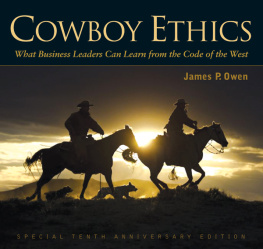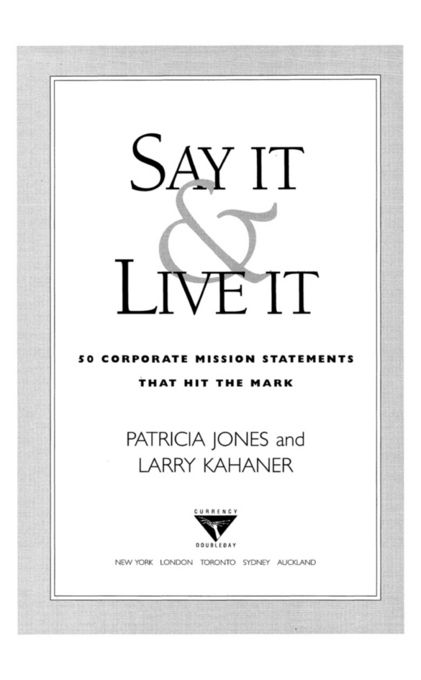OTHER BOOKS BY LARRY KAHANER
N ONFICTION
Cults That Kill
On the Line
The Phone Book (coauthor)
F ICTION
Naked Prey (under the pseudonym Larry Kane)
A C URRENCY B OOK
PUBLISHED BY DOUBLEDAY
a division of Bantam Doubleday Dell Publishing Group, Inc
1540 Broadway, New York, New York 10036
C URRENCY and D OUBLEDAY are trademarks of Doubleday,
a division of Bantam Doubleday Dell Publishing Group, Inc
Library of Congress Cataloging-in-Publication Data
Jones, Patricia, 1954
Say it & live it: 50 corporate mission statements
that hit the mark / Patricia Jones
and Larry Kahaner
p cm.
1 Mission statements I Kahaner, Larry
II Title
HD30 285 J66 1995
658 4012dc20 95-5705
eISBN: 978-0-307-76695-3
Copyright 1995 by KANE Associates International, Inc
All Rights Reserved
v3.1
DEDICATED TO JESSE MARLOWE ,
OUR MISSION
Contents
Road Maps for the
High Road
A recent study of twenty-five corporate tools such as customer surveys, pay-for-performance, total quality management, and reengineering showed that managers used mission statements more than any other tool. The 1994 survey by Bain & Company and The Planning Forum also noted that when managers were asked to list tools in which they were extremely satisfied, mission statements had more votes than any other tool.
Managers like mission statements because they make a difference in whether a company succeeds or fails.
Corporate mission statementssometimes called value statements, credos, or principlesare the operational, ethical, and financial guiding lights of companies. They are not simply mottoes or slogans; they articulate the goals, dreams, behavior, culture, and strategies of companies more than any other document.
During our research one fact stood out. It was how much companies truly relied on their mission statements to help them through trying times and in making tough decisions. The comment we heard over and over was: We didnt need long discussions about how we were going to handle the situation. The mission statement quickly told us how to act.
We found successful, exciting, and powerful companies that had true values. Their mission statements were not just concepts and philosophies they had cobbled together but were well-thought-out ideas that had helped them meet and exceed their financial dreams, treat their employees well, break free of a crisis, and stake out a piece of the right thing to do. They were road maps for the high road.
Corporate mission statements show us the best in corporate America. They are lofty values and ideals that are worthy of study, thought, and emulation. Refreshingly, they show us a side of corporations that many of us never knew existedthe human side, the emotional side, the values-based side.
We, the authors, think of mission statements somewhat as we do the U.S. Constitution. This document promises a fair trial, for instance, but we all know that doesnt always happen. Injustice exists. The Constitution is also fallible. The original document didnt outlaw slavery. Still, the Constitution is an excellent, much revered, and often imitated set of values. It allows us to aim high and set worthy goals.
These ideals are what mission statements are all aboutworthy goals and aspirations. Sometimes you reach them and sometimes you dont, but you always try because its the right thing to do.
The companies chosen for this book passed two tests. First, they have well-written, well-focused, compelling, or unique mission statements, values, philosophies, visions, or whatever they call them. Second, they try to live up to them.
We discovered that many companies we interviewed wrote or rewrote their mission statement during the 1980s when they were being reengineered, downsized, restructured, or otherwise radically altered. Quite simply, they needed a new philosophy to cope with a changing business climate, which included awareness of cultural diversity, worker empowerment, globalization, environmental stewardship, total quality, teamwork, and emphasis on the customer. Mission statements were being used as a tool to gather the troops and effect a new corporate culture or behavior.
We also were impressed at how passionate company officials were about their mission statements. They were truly proud of what they had done and how they were using these documents. In most cases, people were quite willing to talk to us because it meant a lot to them.
Then there were those companies that wouldnt talk to us at all. These companies had mission statementspretty good ones, we thoughtbut they wouldnt grant us an interview. At first, we couldnt understand why they were unwilling to discuss something positive about themselves. What we surmised was that although these companies had mission statements, they didnt truly live themor try to live them. The last thing management wanted was for their employees to see them quoted in a book about how the company lives up to these ideals, while everyone at the company knows differently. Obviously, these companies didnt make the book.
We are certain that the companies that cooperated with uscompanies whose senior officials spent time discussing their mission statements and how they were usedtruly employed their mission statements as advertised. Theyre confident that those throughout the company wont snicker when they read managements comments.
We were gratified at the high level of interest our inquiries received. More than half of our interviews were with chairmen, CEOs, COOs, presidents, and people of that stratum. Indeed, this signaled to us immediately how strongly these companies felt about their values and principles.
We were also intrigued by how many of the companies we spoke to have been chosen as great places to work in such books as The 100 Best Companies to Work For in America. This was coincidental, but in retrospect we shouldnt have been surprised. These companies demonstrated through their mission statements how important employees were to the companies success.
Many of the companies profiled here also turned out to be industry leaders, companies that have the lions share of a market or produce the best in their industry. Also not surprisingwhen we look back at itwas how many companies, five to be exact, have been winners of the prestigious Malcolm Baldrige National Quality Award, established by Congress in 1987 and given by the Department of Commerce for quality management. (Some have been two-time winners.)
We were taken aback by the number of companies that were in the process of writing or rewriting their mission statements. Several told us to try them again for the next edition.
To sum up, we found the companies that truly lived their mission statements were hands-down winners in many different areas. This correlation showed us time after time how mission statements can make a difference.
In most instances we either reproduced the mission statement exactly as its presented or simply copied the mission statement word for word. It seemed to us that some statements benefited more by exact reproduction than others.
In some cases, though, we didnt include all parts of a companys mission statement. Sometimes we skipped the obviousWe will be the best widget company in the world, blah, blah, blahand in rare instances we were forced to cut the mission statement because it was too long. We apologize for taking these liberties.









